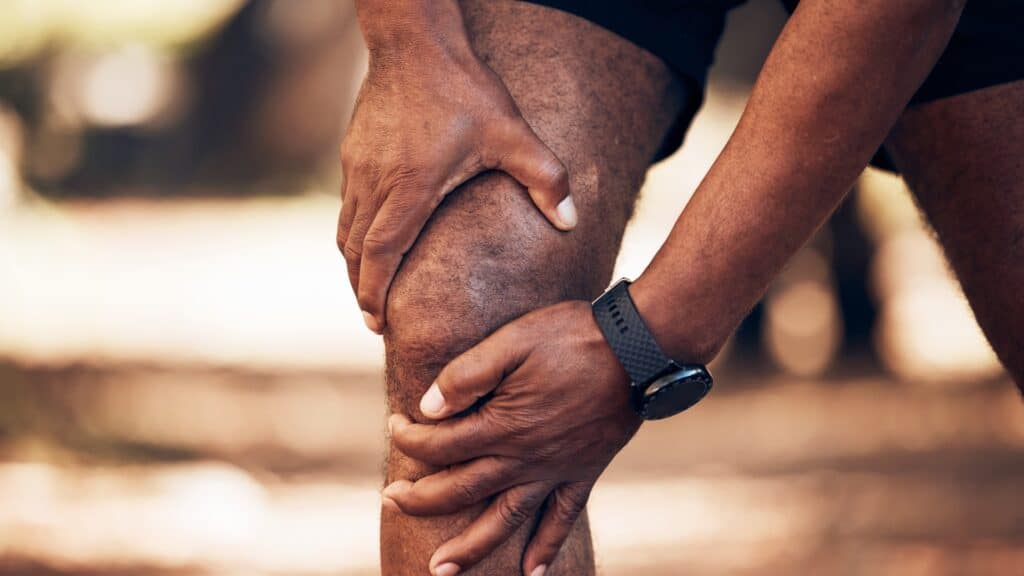Iliotibial Band Friction Syndrome or IT Band Syndrome (ITB) as it is often called is one of the most common running knee injuries around.
In this article, we’re going to explore what IT Band Syndrome is, what causes it, how to treat it and, how to prevent it…
…Even though IT band syndrome is quite a complex injury, it’s quite simple to fix.
In this post we’ll take a look at the following: (Click on any of the links to visit the relevant section)
- What is IT Band Syndrome
- What are the causes of ITB Band Syndrome
- Can you continue running if you have ITB
- How to relieve the pain from IT band syndrome
- How to treat IT Band Syndrome
- Cross-Training if you have IT Band Syndrome
To start with, let’s look at the beast we’re dealing with.

What Is IT Band Syndrome?
IT Band Syndrome is an overuse injury of the thick band of connective tissues, called fascia, that run along the lateral, or outer part of your leg, from your pelvis, along your outer thigh down to your knee joints.
In basic human physiology, it is the iliotibial band that helps stabilize your knee when you run.
The IT band connects your buttocks (the gluteus medius and the gluteus minimus) to the top of your shinbone, or tibia. This keeps the side of your knee where it should be through its range of motion.
IT Band Syndrome is the most common cause of lateral knee pain in runners. ITB syndrome will often present itself as pain and tenderness down the side of your thigh into your knee.
What Are The Causes Of IT Band Syndrome?
As discussed already, ITB is very common and if you end up getting IT Band Syndrome there are five risk factors to look at:
- Overuse or overtraining
- Tight hip flexors
- Weak Glute Muscles
- Poor Biomechanics or running form
- Incorrect or worn-out running shoes
- Let’s dig into each of these reasons in a bit more detail.
Besides being a running injury, IT Band Syndrome is very much a lifestyle injury too (as you’ll discover in these causes of ITB).
Overuse or overtraining
Overuse injuries in runners are more common than we like to admit. Very often our enthusiasm to train and reach our goals leads us to do too much mileage too soon.
The best way to ensure you don’t overtrain is to follow a well-structured training plan. It is important that the training plan you follow also matches your current running ability and training volume.
You can read this article if you want to learn more about the benefits of following a structured training plan.
Tight Hip Flexors
Your hip flexors are the group of muscles that allow you to move your legs or knees up towards your body. They are also instrumental in allowing you to bend your body forward at the hip.
For many of us, our jobs dictate that we sit for many hours a day. Sitting hour upon hour, day after day has caused our hip flexors to shorten and tight up.
This tightening forces your hips and pelvis to close, which in turn affects your body’s alignment and when combined with weak glute muscles is a recipe for disaster.
Weak Glute Muscles
Once again, due to lifestyle reasons, most runners have weak glute muscles. Your glutes, which are made up of the gluteus maximus, the gluteus medius and the gluteus minimus, help stabilise your hips and pelvis.
When your glutes are weak they allow your pelvis to become internally rotated and the IT band then pulls the knee out of alignment. When these weak hip abductors are combined with tight hip flexors, as discussed above, the issue is compounded. (We’ll discuss how to fix both of those issues later in this article)
Poor Biomechanics or Running Form
Sadly, we’re not all blessed with perfect bodies or running form a Kenyan would be proud of.
Unfortunately, some people are born with poor alignment and for others, traumatic events like an automobile accident can negatively affect our biomechanics. These alignment issues can put pressure on the stability
We can’t choose the genes we’re born with but there are things we can do to improve our biomechanics and form and we’ll discuss them in a bit more detail under the treatment of IT Band Syndrome section.
Incorrect or worn-out running shoes
This is one of the least common causes of IT Band Syndrome but is worth investigating if you’re trying to recover from ITB.
Running in shoes that are not suited to your biomechanics or running in shoes that are well past their ‘use by date’ can also agitate the IT Band.
Can you continue running if you have IT Band Syndrome?
The four-letter word runners hate the most is rest, but the great news is that IT Band Syndrome is what is known as a low-level inflammatory issue so rest hardly ever solves ITB.
In other words, the only time you feel pain in your IT Band is when you’re running. And so your body really doesn’t see it as a priority because it’s actually not that debilitating.
It is irritating and can become quite painful but it very seldom gets the point where it’s so painful that actually, you cannot run anymore.
That, however, doesn’t mean you shouldn’t treat ITB and try and run through it.
We’ll dig into the treatment of IT Band Syndrome next but it is important to cut back mileage and treat it, otherwise, you are going to struggle with ITB for months and months.
How to relieve the pain from IT band syndrome
Treating IT Band Syndrome is the only way to continue to run pain-free but here is a list of things you can do in the short term to relieve the pain associated with IT Band Syndrome:
- Reduce your running mileage
- Ice the affected area around the IT band
- Seek assistance from a physiotherapist
- Massage
- Take an over-the-counter anti-inflammatory
- Using ultrasound and electrotherapy can also reduce the tension in the IT band
And as mentioned before ITB is a low-level inflammatory condition so you are able to run through the pain and discomfort but it is important to treat it.
How to treat IT Band Syndrome
There are a few steps you can take to treat IT band syndrome fast: (Some are more conservative treatments than others)
- Consult a physiotherapist
- Stretch your hip flexors
- Strengthen your glute muscles
- Massage
- Foam Rolling
- Dry needling
Let’s dig into each one in a bit more detail:
Physiotherapy for IT band syndrome
The first place I always recommend you start when treating IT band syndrome is to consult and have a physical exam with a physiotherapist or a specialist in sports medicine to help with the inflammation.
It’s also important to see a professional so they can do a thorough assessment and make sure that you do actually have IT band syndrome.
Stretches for IT band Syndrome
The next step in treating IT band syndrome is with hip flexor stretches and glute strengthening exercises.
In our experience having dealt with and coached thousands of runners, 9 out of 10 iliotibial band syndromes are caused by a combination of overuse, very tight hip flexors and weak glutes.
A fantastic exercise to stretch out your hip flexors is a lunging hip flexor stretch. This is how to do it:
The first thing you do is kneel on your right knee keep your left knee bent and place your left foot flat on the floor in front of you.
Then stretch your right hip towards the floor by leaning forward.
Ensure that you clench your glutes while doing this as this will stretch your hip flexors even more.
You can hold that stretch for between 30 seconds and 1 minute 30 seconds, then switch sides and repeat the process.
Strength exercises for IT band syndrome
As mentioned already, strengthening your glutes will go a long way to treating and preventing ITB. There are a number of exercises that are extremely effective in improving the strength of your glutes. (Some are harder to do than others)
Here is a list of exercises you can do:
- Forward and lateral band walks
- Clams*
- Hip raises (Both double and single leg)
- Hip March
- Hip Thrust
- Kneeling arm and leg raise*
- Lunge
- Bulgarian squat
*These are two of my favourite exercises to build glute strength. You can watch the two videos below to see how to do them correctly…
Massage for IT Band Syndrome
Research has shown that massage is effective in treating IT Band Syndrome, particularly when it is also focused on the area surrounding the IT band.
It is for this reason that we recommend seeing a physiotherapist or trained sports masseuse to make sure the massage therapy is being done correctly.
Foam Rolling for ITB
Foam rolling as a type of treatment falls under the category of massage and as discussed above, massage, in general, is effective in treating IT Band Syndrome.
However, using foam rollers as a standalone treatment has been proved not to be that effective on its own.
A recent scientific study published in the Scandinavian Journal of Medicine and Science in Sport showed that there wasn’t a significant improvement in foam rolling was used to treat IT band syndrome. (Falvey EC, Clark RA, Franklyn-Miller A, et al. Iliotibial band syndrome an examination of the evidence behind a number of treatment options Scand J Med Sci Sports. 2010 Aug;20(4):580–7)
Dry needling for IT Band Syndrome
Dry needling is an underused but effective treatment for a chronic case of IT band syndrome.
A study published in the International Journal of Sports Physical Therapy showed that dry needling helped reduce the pain associated with IT band syndrome. (Ron Pavkovich, PT, DPT, Cert. DN, Cert. SMT, Dip. Osteopractic, CIDN. The use of dry needling for a subject with chronic lateral hip and thigh pain: A case report Int J Sports Phys Ther. 2015 Apr; 10(2): 246–255)
One word of caution, however, dry needling for ITB should only be done by a physical therapist or professional who is trained to administer such treatment.
Cross Training and IT Band Syndrome
For most runners, the thought of losing fitness due to an injury like ITB is concerning so cross-training is a great alternative to keep your fitness levels up while treating the symptoms and causes of ITB.
Normally cycling is fantastic cross-training for runners but in the case of IT band syndrome, it is not ideal. Being hunched over the handlebars of a bicycle further tightens your hip flexors and can aggravate the problem even further.
Swimming and using an elliptical are fabulous forms of cross-training when dealing with ITB.
In conclusion, if you do suffer from IT band syndrome get it treated as soon as possible. If you take swift action you can be back on the road or trail faster than you think and without losing any fitness.



Comments are closed.